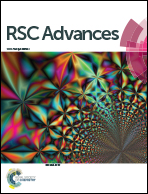Cation dependent charge transport in linear dicarboxylate based isotypical 1D coordination polymers†
Abstract
Two new mixed-ligand one-dimensional coordination polymers (1D CPs) [Cd(adc)(4-phpy)2(H2O)2], (1) and [Zn(adc)(4-phpy)2(H2O)2], (2) (H2adc = acetylenedicarboxylic acid and 4-phpy = 4-phenylpyridine) have been synthesized and well characterized by elemental analysis, infrared spectroscopy, single crystal X-ray diffraction, powder X-ray diffraction (PXRD) and thermogravimetric analysis (TGA). Both compounds 1 and 2 are isostructural and fabricate 3D supramolecular networks by the combination of hydrogen bonding and C–H⋯π interactions. Interestingly, these two materials exhibit electrical conductivity and reveal Schottky barrier diode behavior. To shed light on the charge transport mechanism of the compounds, the mobility, transit time, diffusion length and density of states at a quasi Fermi level have been derived. The analysis indicates that compound 1 has higher mobility (9.15 × 10−7 m2 V−1 s−1) and diffusion length (1.116 μm) in comparison to compound 2 (mobility and diffusion length are 5.44 × 10−7 m2 V−1 s−1 and 1.050 μm respectively). Compound 1, with the larger cation and shorter H-bonding distance, shows higher electrical conductivity, which is 2.55 times greater than compound 2.



 Please wait while we load your content...
Please wait while we load your content...